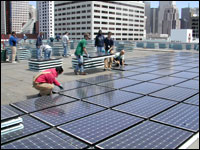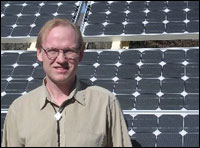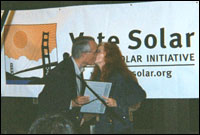Adam Browning is the cofounder and director of operations for Vote Solar Initiative, a nonprofit organization working to jump-start the transition to renewable energy by helping municipal governments implement large-scale and cost-effective solar energy projects.

Monday, 26 Jan 2004
SAN FRANCISCO, Calif.
It’s Monday, but I will begin my story a little over two years ago, on Nov. 7, 2001. The day before, voters in the city of San Francisco had passed — by a whopping 73 percent — a ballot measure authorizing $100 million worth of revenue bonds to put solar and energy-efficiency technologies on public buildings, to be paid for with energy savings. It was a big win, and as the news spread, other cities across the country were calling campaign HQ and asking: How did you do it? Can we do it here? Who was your opposition?
All these questions made me and my business partner, David Hochschild, think of another: Why stop now? The San Francisco campaign was a grassroots effort, but we figured that if we could replicate it, we’d have a good chance of helping the solar industry build economies of scale, bringing down solar’s costs, and letting market forces do something for global warming that even Dick Cheney couldn’t stop.
Ten cities in two years, we figured. Easy. So we quit our jobs, Dave’s in the mayor’s office and mine with the U.S. EPA, subleased some office space from our friends at Fenton Communications, applied to become a project of the Tides Center, and started writing grant proposals. Game plan: Focus like a laser on municipalities, as they are large energy users, can borrow money cheaply through bonds, and are comfortable with long-term paybacks.

Catching rays at the Moscone Convention Center.
Fast-forward to today. San Francisco is doing its part — the first project implemented, a 675-kilowatt solar roof and energy-efficiency retrofit for the Moscone Convention Center, provided net savings to the city of about $210,000 a year while paying off the capital costs and much more after that. We are well on our way to the 10-city goal, but it hasn’t been easy. Bonds have proven to be only one source of potential financing, and we haven’t been able to focus like a laser. As anyone who has been doing this for a while knows, impediments to expanding the solar industry’s penetration are many, varied, and people are not necessarily impressed with Vote Solar’s can-do optimism.
Take net metering, for one. Net-metering laws allow solar-array owners to get credit for surplus electricity fed back into the grid — say, during the day, when the sun is most intense and homeowners are not at home. The meter literally rolls backward; the ability to feed surplus into the grid effectively makes solar 25 percent cheaper for system owners. During the electricity crisis of 2000-2001, California increased its net-metering limit to a nation-leading one megawatt, and the industry responded: large-scale installations increased by more than 1,000 percent. In August 2002, the expanded net-metering provision was due to sunset, threatening the newfound momentum behind large-scale solar. Utilities fought to get rid of net metering and solar advocates had to stop what they were doing to fight back. The Vote Solar Action Fund, Vote Solar’s 501(c)(4) lobbying arm (also a project of the Tides Center), funded a full-page ad in the West Coast edition of the New York Times, about 2,500 people sent emails of protest to the Public Utilities Commission, lobbyists on both sides switched into high gear, and, in the end, California’s 1-MW net-metering standard persevered.
Nonetheless, it was a pointed lesson: The proliferation of solar depends on the correct regulatory infrastructure. We’ve had to fight similar fights to preserve existing rebate programs, and almost surrealistically, what would have amounted to a tax on solar electricity to pay for California’s long-term and above-market contracts, signed to stabilize supply during the electricity crisis.
The above-mentioned litany of woes is cited simply to make the point that even organizations built around one central project end up having to pull resources away to fight necessary battles and prepare the ground for what they really want to be doing.
And in that vein, tomorrow it’s on to the good news: A solar bond is being introduced in New Mexico. Stay tuned.
Tuesday, 27 Jan 2004
SAN FRANCISCO, Calif.
Today, if all goes well, a $20 million Solar Bond will be introduced in the New Mexico state legislature.
It’s been a long, slow dance to get to this point. Shortly after Vote Solar’s inception, we conducted an analysis of the places in the U.S. where solar is most attractive, financially speaking. Factored into this analysis were cost of electricity, available rebates, and solar insolation. New Mexico, despite a lack of rebate money, turned up seventh on the list.
“All politics is local,” someone — probably Tip O’Neill or maybe Mark Twain — once said. If he’d been an environmental advocate, he would have amended, “And if you are trying to do something in the environmental realm, you’d better get the buy-in of local groups, or your idea is going to stay local.”
Good advice, Tip. So, the first thing I did was make a list of all the environmental groups working in New Mexico and call them up. I laid out the Vote Solar model, talked about how it is being implemented in San Francisco, and shared some facts and figures about how the solar-retrofitted Moscone Convention Center is saving the city money. More importantly, I laid out why I thought something similar could work in New Mexico. I asked about their agendas, whether there were any conflicts, and if the conversation went well, whether they might potentially want to carry something like this, with our assistance.

Ben Luce, chair of the Coalition for Clean Affordable Energy.
Photo: Naishing Key.
I talked to a lot of groups doing a lot of great things, but in New Mexico, the Coalition for Clean Affordable Energy is the group working on renewable energy. As the name implies, CCAE is an umbrella organization coordinating the renewable-energy efforts of a bunch of local groups, including the New Mexico Solar Energy Association, N.M. PIRG, Sierra Club, etc. Ben Luce and Amy Welch immediately dialed into the solar revenue bond’s premise and promise, and invited me to come down to their board’s “strategery” session. The board liked it, and so the next step became the seduction of the state government.
We met with state energy officials to explain the model and how it is working elsewhere, including the fiscal and environmental benefits. With Ben and Amy of CCAE plotting the political strategy, I worked with staff from the New Mexico Energy, Minerals, and Natural Resources Department to figure out the size and extent of the energy-efficiency opportunity in state-owned buildings — as energy efficiency has a much quicker payback than solar, this would determine how much solar could be cost-effectively installed. The department estimated that state buildings could use an easy $15 million worth of readily identifiable energy-efficiency upgrades. Using payback estimates based on actual results of recent local projects, we calculated that that amount of energy efficiency could be bundled together with $5 million for solar and still stay revenue-positive using likely bond rates.
Yes, it is a high ratio of energy efficiency to solar, but electricity is cheap in New Mexico, and state buildings get a special deal on top of that. The important thing is to stay revenue-positive — that is, to have the expected energy savings exceed the amortized cost of the capital equipment. It saves money, provides jobs, and cleans the air — a very palatable package that Ben and Amy were able to put in front of the governor, who took the bait and put it on his list of issues to be dealt with in the upcoming legislative session.
At this point, Vote Solar’s alter ego, the Vote Solar Action Fund (our 501(c)(4) lobbying arm), took over and did what organizations do when they are serious about results: chipped in for a lobbyist. It’s not enough to let an idea sell itself on its merits — you need someone who knows all the players, knows how to navigate the local waters, and can explain the idea in a way that is palatable to regional tastes.
The bill hasn’t passed yet, so I share this with you, dear readers, at grave risk of jinxing the whole project. Please do your part and cross a finger or two for solar in New Mexico …
Wednesday, 28 Jan 2004
SAN FRANCISCO. Calif.
Instead of a blow-by-blow account of my day (you don’t want to know — even I don’t want to know — how often I check my email), I thought I’d talk about another project that Vote Solar is undertaking to facilitate solar’s market penetration. Bear with me.
Photovoltaics are one of the most reliable sources of energy ever invented. In applications where reliability is absolutely crucial — say, space satellites, the Mars Rover, about 99 percent of all off-shore Coast Guard buoys, and other places where repairpeople don’t make house calls — solar is the technology of choice, with a lock on the market as strong as Halliburton’s in Iraq.
Yet, for some reason, many people still think of solar as the tie-dyed pipe dream of the granola-and-Birkenstock set, something that flamed out in the Carter days in a puff of funny-smelling smoke and we-are-the-world saccharine, about as practical as running your car on used vegetable oil, and about as sexy as hemp clothing.
Nothing against hippies — I love ’em, myself — but solar needs an extreme makeover if it is to go mainstream. A re-branding, if you will. In order to do this, one of the projects that Vote Solar is working on, code-named “Hip, Not Hippy,” is a public service announcement for the California television market.
Working with the pro-bono help of people who do this for a living, we went through a strategic messaging process. Phrases like “solar’s singular promise” and “target consumer’s psychographics” and “highest order benefits” were thrown around a lot. I feel like we got a peek behind the curtain at how ads are conceived and how things like the Hummer and the Mini get popular. In the end, the challenge is to sell solar at the 10,000 foot level: This is something that the savvy, smart, and sophisticated consumer wants, and it’s a good choice for both the wallet and the Earth.
The team developed a perfect piece, with actor George Hamilton cast in the starring role. Think about it: Who better than the Man with the Tan to pitch the benefits of solar energy? It has a little bit of camp, a lot of humor, and no preaching. Facts about solar’s ease of use and ready availability are worked in subtly, without did-you-know facts and shame-on-you figures.
Unfortunately, you are not likely to see this on the air any time soon because, according to Mr. Hamilton’s agent, he’s busy. And a big bouquet of sunflowers didn’t free him up any. If anyone has an in with the Hamilton camp, please let me know. In the meantime, it’s back to the drawing board. Feel free to email my colleague Charlene Garland (charlene@votesolar.org) with suggestions.
Thursday, 29 Jan 2004
SAN FRANCISCO, Calif.
An update on New Mexico’s progress: As hoped, the solar bond bill was introduced by Rep. Mimi Stewart [D], a strong leader on environmental issues, in the New Mexico legislature, not on Tuesday as originally predicted, but today. No matter — it’s when it gets passed that counts. You can track developments of House Bill 380, the Energy Efficiency and Renewable Energy Bonding Act, on the Coalition for Clean Affordable Energy’s website, or get it straight from the horse’s mouth on the N.M. legislature website.
A little more backstory on the bill’s journey: In the absence of federal leadership, much energy policy is made at the state level. Gov. Bill Richardson [D], formerly Clinton’s secretary of energy, has folded the solar bond bill into a package of related clean-energy policies that he is promoting, namely:
- Codification into statute of New Mexico’s Renewable Energy Portfolio Standard (RPS), which requires utilities to provide 10 percent renewable energy in their mix by 2011;
- A $2 million Clean Energy Fund which would provide $1.5 million for renewable energy and energy-efficiency projects and $500,000 for hydrogen-related research and economic development;
- Several tax exemptions for wind-energy equipment and energy-technology manufacturing firms; and
- An excise tax exemption for hybrid automobiles with mileage better than 27.5 mpg.
In addition to these bills, the governor has also announced the formation of a task force to develop a utility-scale solar-power project, and has announced his plans to provide $6 million in state funding for a variety of energy-efficiency and renewable-energy projects.
We are particularly excited about seeing good things come out of New Mexico because Gov. Richardson is influential with the Western Governors’ Association. We are hoping that he will take a moment at their next meeting to talk about how the solar-bond bill is guaranteed to save the state money from day one while preventing, annually, air emissions of about 93 million pounds of carbon dioxide (a key global warming gas), 223,000 pounds of nitrogen oxides (which plays a large role in the formation of ground level ozone, aka smog, and is a serious factor in respiratory illnesses), and 176,000 pounds of sulfur dioxide (acid rain, anyone?)*.
And hey, if it goes over well with the WGA, that can’t help but increase the chatter heard from some quarters about how Gov. Richardson would be a good candidate for vice president, right?
Solar bond as catapult to the White House? Vote Solar and CCAE, kingmakers? Uh huh. A guy can dream, anyway. But take a moment and imagine how different the world would be if this country had a vice president focused on energy issues of the renewable variety.
*[Correction, 04 Feb 2003: The emission reductions numbers have been updated to reflect more accurate calculations. It orignially estimated emissions reductions of 64 million poinds of carbon dioxide, 130,000 pounds of nitrogen oxides, and 260,000 pounds of sulfur dioxide.]
Friday, 30 Jan 2004
SAN FRANCISCO, Calif.
It’s a good story. After our initial success in San Francisco, San Diego was Vote Solar’s next area of focus. The process started in the usual fashion: Vote Solar (in this case, David Hochschild, our other cofounder) collaborated with other interested groups, most notably Greenpeace, to pitch the benefits of an ambitious solar program to influential parties, in gradually narrowing concentric circles around elected officials, until we got a meeting with Mayor Dick Murphy. Murphy, feeling a bit battered by the energy crisis, had made energy independence a goal for the city.
We brought in Ed Smeloff, assistant general manager for power policy for the S.F. Public Utilities Commission (i.e., the person responsible for keeping the city’s lights on), to discuss San Francisco’s solar bond. Murphy, a Republican generally described as a fiscal conservative, liked it, especially the fact it was revenue positive. Solar is very much a nonpartisan issue.
It’s one thing to like an idea; it’s quite another to grind the wheels of government into motion. Inertia — the tendency of bodies at rest to stay at rest — is endemic to bureaucracies, and really a ferocious force. The problem became: How do we turn general warm feelings about the idea into actual solar panels on roofs?

Bonnie seals the deal with Mayor Murphy.
Enter Bonnie Raitt. The singer/activist works for countless causes; on her last tour, called Green Highways, she spotlighted a different environmental organization at each show, donating a block of seats to be sold at a premium to supporters and hosting a backstage reception. Vote Solar got the San Diego show. We worked with a local radio station (KPRI 102.1) and the Guacamole Fund, and the tickets went like hotcakes. We also gave a pair to the mayor and his chief of staff.
Lights dim, audience settles down, Lyle Lovett strums and croons, Bonnie struts on stage, whips up the crowd with some foot-stomping numbers — and then, mid-set, she stops, talks a little about the environmental aspects of her tour, and says: “This next song, I’m dedicating to Mayor Dick Murphy, who is going to make San Diego the solar-energy capital of the United States.” The crowd goes wild.
Backstage after the show, Mayor Murphy, blushing like a teenager and gushing just a bit, proclaims the day “Bonnie Raitt Appreciation Day.” With ABC’s cameras rolling, Bonnie, nobody’s fool, prompts him to be specific with his solar goals. He was putty in her hands.

Nicole Capretz and Councilmember Donna Frye.
End of story, right? Not yet. I can’t stress this enough: No matter the good intentions, nothing ever gets done without an internal champion, someone who takes an issue on, makes it their own, and bulldogs it through to completion. In this case, the aforementioned champions are Councilmember Donna Frye and her senior policy advisor Nicole Capretz. They took this momentum, articulated a goal of 50 megawatts of clean, renewable energy on public and private buildings within city limits by 2013, and codified it into a city council resolution. The resolution also established an advisory board to recommend policies and actions for meeting the goal.
On Monday, the Sustainable Energy Advisory Board, a highly motivated group of local solar-industry representatives, business owners, electricity wonks, and solar supporters, is meeting for the third time. The chair is Mike Turk, a local developer who puts his money where his mouth is in the form of solar on all his projects. I’m going to chip in my two cents.
Having been through this before, I believe that eventually the board will end up dividing the task into different categories of roof owners: public buildings, commercial space, residential retrofits, and new buildings. Each category will need a different policy tool.
San Diego has already put 180 kilowatts of solar on its public buildings, and as that’s where they have the most control, will likely need to do much more in order to meet their goals. The big question will be how best to finance it; Vote Solar can also recommend some tricks for bringing down the effective cost of installation. Private roofs, both commercial and residential, will require some innovative thinking and programs, as the city does not have direct control over them. I’ve got some suggestions there, as well.
As for new buildings, San Diego has already implemented a really clever and innovative policy — if you are a developer and need a construction permit, you should know that permit applications for buildings that generate at least 15 percent of their expected load using renewables go to the top of the pile. It’s called expedited permitting — an ingenious way of harnessing bureaucracy’s evil for the forces of good.
So, that’s what I did today. Despite my best efforts, this job is less about hanging out with rock stars than about writing memos on policy options and trying to get invited to meetings that I’m not invited to. Live the glamour.


